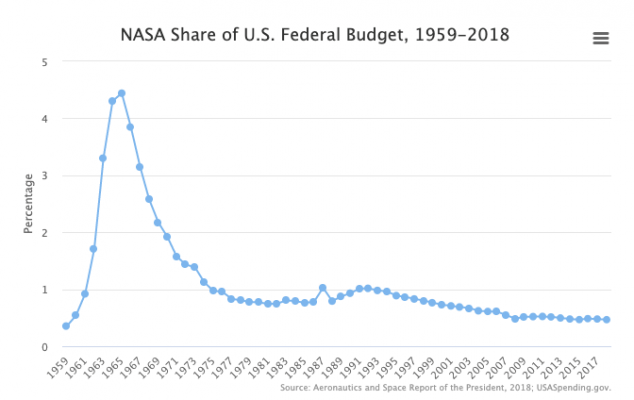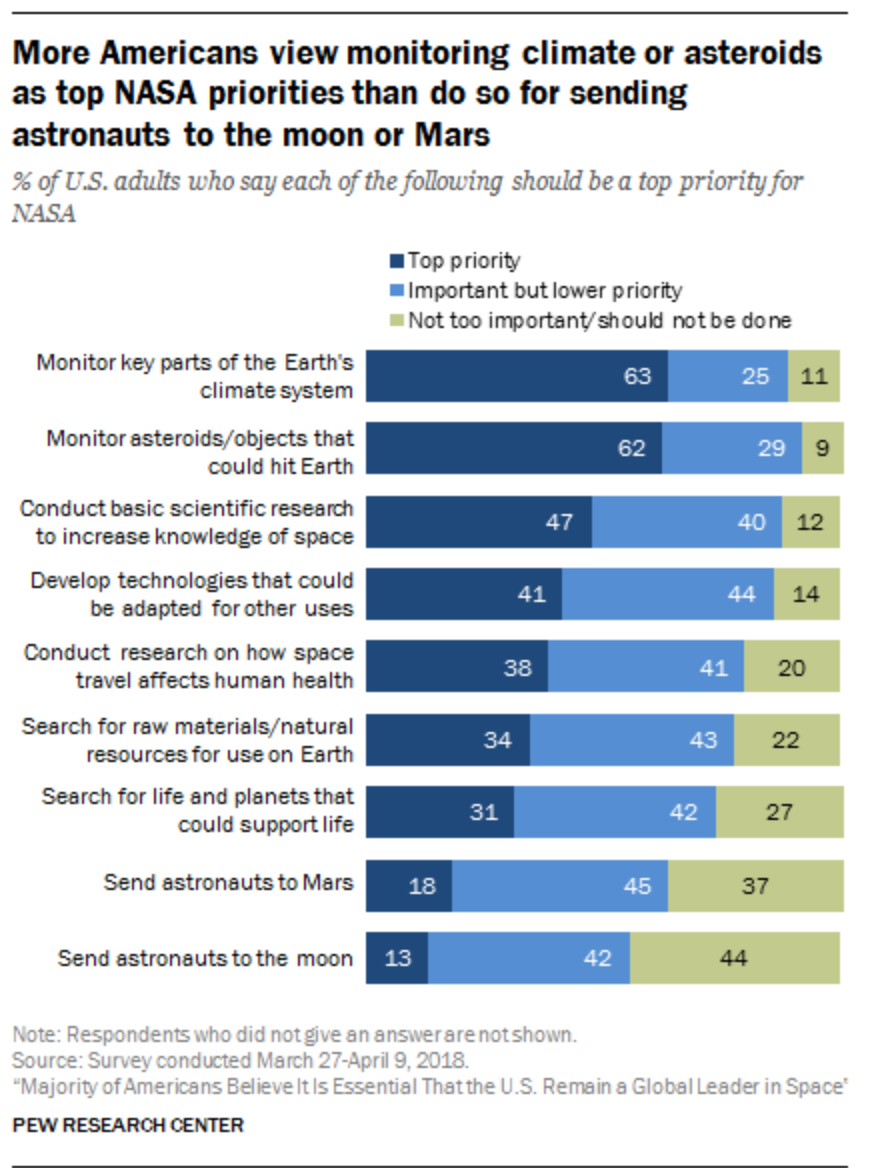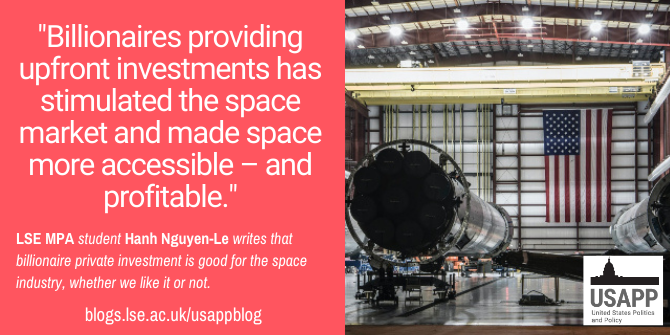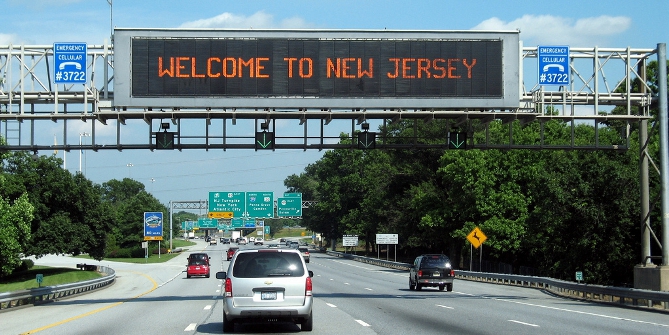 This month sees two billionaires – Richard Branson and Jeff Bezos – perform suborbital flights on vehicles designed by their own companies. Hanh Nguyen-Le tracks the recent history of billionaire space projects, from space tourism, to operating commercially and contracting with the federal government. Despite billionaires’ unpopularity with much of the public, they argue that billionaire-involvement in space is a good thing – driving down costs, saving money for the space efforts of national governments, and increasing access to space in the long-run.
This month sees two billionaires – Richard Branson and Jeff Bezos – perform suborbital flights on vehicles designed by their own companies. Hanh Nguyen-Le tracks the recent history of billionaire space projects, from space tourism, to operating commercially and contracting with the federal government. Despite billionaires’ unpopularity with much of the public, they argue that billionaire-involvement in space is a good thing – driving down costs, saving money for the space efforts of national governments, and increasing access to space in the long-run.
On 11 July UK billionaire businessman Richard Branson travelled to the edge of space in a spaceplane developed by his company, Virgin Galactic. On Tuesday this week, the billionaire founder of Amazon, Jeff Bezos, will take a similar trip to space aboard the New Shepherd rocket built by his Blue Origin company. Elon Musk’s SpaceX will soon begin sending paying civilians into Earth orbit with the company’s Falcon 9 rocket. The ability of such billionaires to afford private spaceflight trips or invest in heavy-lift rockets, while paying a smaller fraction of income in tax than the average American, reflects inequality in America. This inequality has been made especially stark during the COVID-19 pandemic with billionaires’ wealth increasing while many others experienced financial hardships.
Increasing wealth and reaching for space has not purchased popularity for these billionaires. Ahead of Bezos’ upcoming suborbital flight, a petition to “not allow Bezos to return to Earth” gained more than 160,000 signatures. Richard Branson has been criticized for using his wealth to go to space rather than addressing more terrestrial problems like climate change. But after half a century of government-led exploration beyond earth, why are billionaires now at the forefront of our minds when we think about space travel, and what do they mean for how we go to space?
The private sector has always had a close involvement with space
Billionaire interest in space is not new. Historically, science research funding for observatories in the 19th and 20th centuries was typically provided through endowments from wealthy individuals. Institutions such as the Smithsonian and the Guggenheim family were the early donors of Robert Goddard’s ambitious projects to develop rockets and space technology.
Following 1980s initiatives like MirCorp’s plan to provide privately owned space stations, the 1990s and 2000s saw commercial space efforts like Peter Diamandis’ introduction of the Ansari X Prize (1996), the US government’s Alternate Access to [the International Space] Station Program (2000-2002), and the founding of Mojave Aerospace Ventures (2004). Between 2001 and 2009 seven wealthy people went to space as paying customers on Russian Soyuz rockets including Dennis Tito, Iranian American businesswoman Anousheh Ansari and Cirque du Soleil founder Guy Laliberte.
More recently, aside from Jeff Bezos and Richard Branson, other billionaires have also planned trips to space, including Jared Isaacman and Yusaku Maezawa. The wave of billionaires now seemingly interested in space exploration is a return to a past trend.
Space exploration is expensive
Private actors and the government think differently when it comes to what type of space programs to prioritize. The government prioritizes aspects of a space program that are in the public-interest such as national security and Earth sciences, while wealthy individuals that enter the space sector are interested in personal and financial endeavors that involve space exploration, such as making life multiplanetary for Elon Musk and space tourism for Richard Branson and Dennis Tito.
The Apollo program which ultimately sent astronauts to the moon in 1969 is thought of as the height of US government leadership in space. But the massive investment which made the first moon landing possible was an anomaly that had been driven by political necessity given the climate of the Cold War. As Figures 1 and 2 show, by 1965, the US government had begun to cut NASA’s budget to the point that by the 1970s it made up only about 0.5-1 percent of the total federal budget. According to Dr. John Logsdon of George Washington University’s Space Policy Institute: “From 1970 onward, NASA has not had a budget adequate to support a robust program of human exploration.”
Figure 1 – NASA’s budget from 1959 – 2025

Source: The Space Report
Figure 2 – NASA’ share of US federal Budget 1959-2018

Source: The Space Report
The lackluster interest in space exploration by the US government since the 1970s sits alongside with a similar lack of enthusiasm by the American public. In a 2018 survey conducted by Pew Research Center, a majority of American adults believed that that monitoring Earth’s climate system should be the highest priority and sending astronauts to Mars and the Moon the lowest (Figure 3).
Figure 3 – Americans’ views on policy priorities

Source: Pew Research Center, 2018
Re-emergence of commercial space
At the same time, many wealthy individuals have been dissatisfied with the lack of public enthusiasm and the lack of progress in recent years due to the government’s traditional view of space operations, and failures of the Space Shuttle. Wealthy individuals like Musk believed that they could spur a robust marketplace for providing access to space which could work alongside and provide services for government space agencies by leveraging reusable technologies, lean manufacturing, and vertically integrated production to enable cheap space access. Because typical debt and equity investors are unwilling to finance the risks of space exploration and the government is unable or uninterested in large up-front investments, it is natural for private space exploration to be funded out of billionaire’s own wealth initially, with government support through development contracts.
Government support and US Commercial Space Policy
Without the government, the private sector cannot thrive in space. The government supports the private sector by adopting regulatory reforms or creating contracts and awards. Early attempts to invigorate the commercial space industry include the 1984 Commercial Space Launch Act, which was unsuccessful as US launch firms were unable to compete against NASA’s Space Shuttle. President Reagan’s 1986 US Space Launch Strategy reduced NASA’s ability to provide commercial launches, which led to the re-emergence of commercial space activities. The limitations provided by the 1986 policy led to the first commercial space launch by Space Services, Inc. in 1989.
The US government under the Obama administration made policy reforms such as introducing fixed price contracting to support development of commercial services. An example of this was a request for over $6 billion to subsidize commercial crew vehicles to visit the International Space Station for the Commercial Crew Resupply (CRS) program. Congressional appropriators in the Senate created a “Dual-track” approach, exemplified by the 2010 NASA Authorization Act, which calls for commercial cargo development. The bill shows that policymakers were willing to compromise on certain aspects of the space program such as CRS to support private space launch companies. By 2010, commercialization was well underway with Obama’s National Space Policy that emphasized supporting a “competitive US commercial space sector.” As of 2011, NASA had paid SpaceX $181 million for 14 Commercial Resupply Missions and $298 million under the Commercial Orbital Transportation Services Demonstration Agreement. The Trump Administration increased public investment in private space actors further and established a series of Space Policy Directives that were meant to bolster the commercial sector.
Government support to the private sector further comes in the form of NASA- approved loans, loan guarantees, and tax credits. Firms can also receive tax exemptions through facility constructions, discounted loans, and environmental credits. It is estimated that all of Musk’s ventures, not limited to SpaceX, received at least $4.9 billion in government support through tax breaks, factory construction, discounted loans, environmental credits, facility loans, and rebates to product buyers.

Photo by SpaceX on Unsplash
How billionaires support the space industry
Private investment in space has created competition and reduced space launch costs. New space actors began to challenge the government-created monopoly, United Launch Alliance (ULA), for contracts, creating competition and introducing a market for small-medium class reusable launch. SpaceX’s Falcon 9’s average cost is $62 million, while ULA’s Atlas V starts at $110 million per launch.
Commercial actors enable the government to have multiple competitive proposals to select from during project development. NASA would pay less money upfront for a service, while private companies can operate and have autonomy over their final product. The government can act as a buyer of commercial services, which allows NASA to be more efficient and cost-effective, as the agency can cut costs by only developing projects it has expertise and funding for.
Such competition has dramatically changed space technology. New players that enter the space industry are able to embark on ambitious projects at a greater scale and faster pace. Innovative concepts such as reusable rocket stages has shifted the launch industry into integrating reusability into vehicle design and the proliferation of ridesharing missions has decreased the costs of space launch. This has lowered barriers to enter the space industry, making small satellites rideshare as low as $1 million per mission. Innovations in space launch have further changed the policy environment and streamlined launch and reentry regulations.
Billionaires in space are here to stay
Investment from wealthy individuals in recent decades have stimulated private markets and paved the way for many startups to enter the industry. As more new players join the commercial space industry, access to space becomes cheaper, resulting in an explosion of proposed satellite constellations and small launch vehicle concepts.
Wealthy entrepreneurs have seen an opportunity to take advantage of a lack of government interest in space exploration funding. The high-risk nature of space exploration requires substantial upfront investment that only wealthy individuals can provide before any pay-off. Private investments in space promote competition and innovation. Billionaires providing upfront investments has stimulated the space market and made space more accessible – and profitable.
Please read our comments policy before commenting.
Note: This article gives the views of the author, and not the position of USAPP – American Politics and Policy, nor the London School of Economics.
Shortened URL for this post: https://bit.ly/3eygYTj
 Hanh Nguyen-Le – LSE MPA
Hanh Nguyen-Le – LSE MPA
Hanh Nguyen-Le is a second-year Master of Public Administration student at the London School of Economics. She is also the Government Affairs Associate at the Space Foundation, a nonprofit advocate organization for space exploration and space-inspired industries, where she focuses on U.S. Congressional relations and national space policy.












